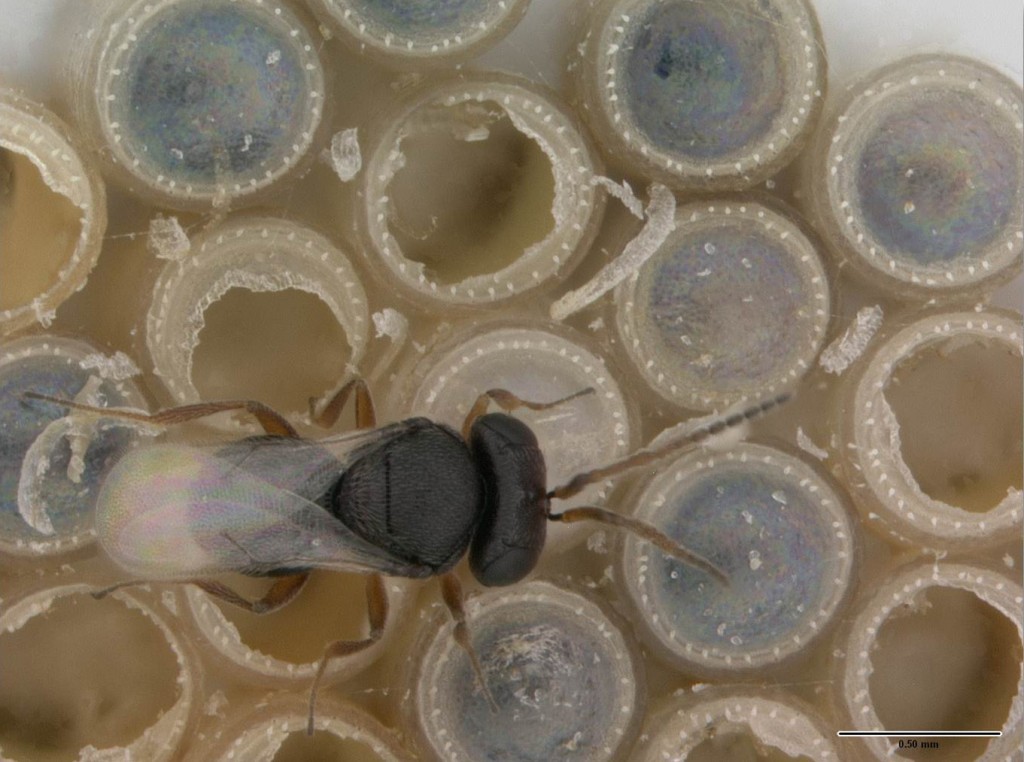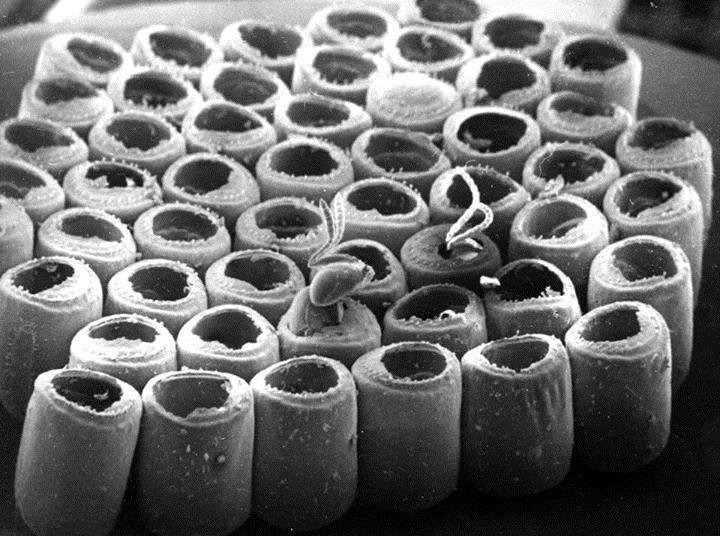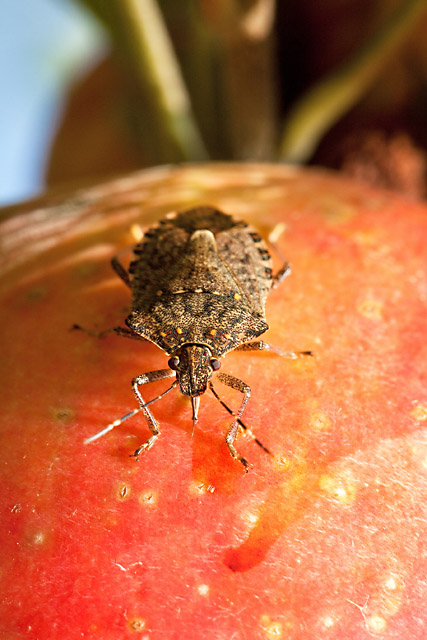Most people are very familiar with wasps – the large, buzzing, stinging creatures such as yellow jackets and hornets. And while there are tens of thousands of different kinds of wasps, they’re just one corner of diversity in the insect order we call Hymenoptera.

The paper wasp, Polistes dominula, is only one of the many kinds of wasps that exist in Nature. Photo by G. White.
Gauld & Bolton estimated (very roughly) that there may be as many as 115,000 species of Hymenoptera – and that’s almost certainly an underestimate. So who are all these other hyms, those that make up the bulk of the order? Well, there are ants (about 13-14,000 different kinds), sawflies and wood wasps (maybe another 10,000 or so). Bees, too are pretty diverse, probably with about 20,000 species. That leaves still about half of the order, at least 50,000 species, that we haven’t accounted for. This is the vast, largely unexplored realm of parasitoid wasps. And that’s where I’ve spent my career in research, focusing on one corner of that realm, trying to figure out what are the species and genera, and how are they interrelated.
Parasitoids?! What a strange word. Is that different than a parasite? Well, yes. We’re all probably familiar with parasites: things like lice, fleas, and ticks, as well as much smaller microbial parasites. Typically, a parasite is a small creature that feeds on a much larger creature. An adult flea sucks the blood of your pet cat or dog; same sort of thing for lice and ticks. The feeding of such a parasite might be annoying, sometimes amazingly annoying, but it isn’t really life-threatening. (Not the feeding of the parasite, anyway. If, at the same time, they’re infecting a person with a potentially fatal disease, such as bubonic plague, that’s a different kettle of fish.)
A parasitoid makes it living in a different way. Just like a parasite, they feed on another organism that we call its host. It’s the immature stages of the parasitoid that do this feeding. Adult parasitoid wasps and flies usually feed on sugar sources like nectar or honeydew. The critical difference is that the parasitoid larva feeds on only a single host and eventually kills it. In many ways it can be thought of as a predator, akin to a lioness that only eats one antelope during her entire life. The interesting part of all this is that under this category of parasitoid there are many variations on the same theme, and some of them are truly bizarre.
There are parasitoids in other groups of insects, and even other arthropods; parasitoid flies (order Diptera) are a world unto themselves. But for my purposes in this post, let’s concentrate on parasitoid wasps.
First, what do they attack? Mostly it’s other insects, although there are examples of host spiders, ticks, centipedes, and probably more. Almost every major group of insects is attacked by its own suite of parasitoid wasps. Probably most of these attack the immature stages of their hosts, that is, larvae or nymphs, things like caterpillars, maggots, beetle grubs, and the like. However, many specialize on the pupal stage; many on the egg stage. There are even a few that attack adult insects. And just because Nature pays no heed to the categories and rules that we devise, there are some kinds of parasitoids that start out in the host egg but emerge later from the larva, and some that start out in the larva and later finish their development in the host pupa. Note that as I describe this variability in life histories, I don’t mean variability among individuals, but differences between species.

A male parasitoid wasp of the species Trissolcus basalis awaiting emergence of females. This species is an example of an egg parasitoid. Photo by Charuwat Taekul.
Is that complicated enough? Well, you ain’t seen nuthin’ yet! Some parasitoid wasps live within the bodies of their hosts (the so-called endoparasitoids), while others feed on them from the outside (ectoparasitoids). We have solitary parasitoids (one per host) and gregarious parasitoids (many per host). Monophagous and polyphagous parasitoids, depending on how many different kinds of host a species can successfully attack. How about polyembryonic parasitoids? In these, a single egg can develop into dozens or even hundreds of offspring. Maybe you prefer hyperparasitoids: these are parasitoids of other parasitoids. But the most bizarre of all must be adelphoparasitoids. These are found in the family Aphelinidae. The females are “normal” parasitoids of whiteflies or scale insects. The males, on the other hand, are hyperparasitoids and their hosts are females of their own species!
Where can you find these fascinating creatures? The answer is in just about any terrestrial habitat. They’re found from the shores of the Arctic Ocean to the southernmost tips of Africa, South America and Australia. They’re found on every continent except Antarctica. (There is only one insect species native to that continent, the flightless midge Belgica antarctica.) Some species are quite large in size, things like Megarhyssa (aka giant ichneumon wasp) or Pelecinus, whose bodies may be 3-4 inches long. At the other end of the scale, some species of parasitoid wasps are among the smallest insects that have ever been found. In fact, most of them are small, even tiny, measuring less than 2 mm in total length (that’s about 1/100 of an inch).
Parasitoid wasps occur in all sorts of habitats, from deserts to rain forests and everything in between. There are even some in which the adults swim underwater to find their hosts, seeming to imply “You can run, but you can’t hide.” This begs the question, how does a tiny wasp find a host to attack in the big, wide world? This is a critically important question for understanding the biology, evolution and practical importance of these animals – more on that last point in a minute.
So, how *does* a tiny parasitoid wasp find a host to attack? Some species rely on vision, either seeing the hosts or by seeing the habitat in which the host lives, for example a dead tree in which horntails are living. Others are capable of using their antennae and legs to detect vibrations in the ground or on plants. These vibrations are caused by the movement and gnawing of the host larva, a sure tip-off of the presence of the larva even if they’re not visible. Some species of parasitoids are reported to have heat-detectors in their antennae, again providing a valuable cue of the location of a host even if it’s hidden from view. But most importantly, parasitoids use their senses of taste and smell to home in on their victims. We’re used to the idea of bloodhounds following the scent trail of an escaped criminal. Parasitoids do the same, tapping in not only on the trail left by a walking bug, but also eavesdropping on the chemical pheromones used by males and females to find one another, or on defensive chemicals used to repel attacks.
The jewel wasp is a parasite of the pupae of flies that breed in animal dung (right, ugh!). Genomic studies of these animals reveal that they have over 300 different kinds of receptor proteins that are used to detect odors in the outside world. There is a great deal yet to be learned about how the senses of taste and smell work in insects, and this is an active area of research.
Finally, we come to the “big” question: Why should anyone care about parasitoids? Sure, they can be beautiful, surprising, bizarre, and endlessly entertaining. But don’t we have bigger fish to fry, more important things to focus our attention on? To try to answer this, think back to the definition of what a parasitoid is: an organism that feeds upon a single host, eventually resulting in the death of that host. This is the important part. Just as the size of deer herds in some parts of the U.S. are growing out of control due to a lack of their natural predators, parasitoids are important in keeping in check the populations of their hosts. The critical role that they play is most clearly seen with invasive species. These are organisms that, somehow, find their way into a new part of the world. With the levels of commercial traffic we see in modern society, often these organisms “hitch a ride” from their native range to new territory. And when they come, they often come without the whole array of their natural enemies from that native range. As a result, the populations of the invaders explode in size. Prominent examples include zebra mussels, gypsy moths, chestnut blight, Dutch elm disease, Russian thistle. Unfortunately, this list could go on for a long time. Without their native natural enemies, there is little constraint to the invaders, and large populations inevitably turn them into things that we categorize as “pests.”
One of the prominent examples today is the brown marmorated stink bug (BMSB). This creature found its way from somewhere probably in northern China (or perhaps Korea or Japan) to the U.S. about 20 years ago. It has since become one of the most common stink bug pests in the U.S. Many people are familiar with them because they will come inside houses to hibernate over the winter, sometimes numbering in the tens of thousands in extreme cases. More importantly, though, these animals feed on a wide range of fruits and vegetables and cause a great deal of damage. For several years now, researchers at the USDA have been working to find and evaluate the natural enemies of BMSB in its native range, in the hope that one of them will prove to be both effective and finding and killing the stink bugs, while not being a danger to our native stink bug fauna. Stay tuned on that one for further developments.
“A parasitoid is an organism that feeds upon a single host, eventually resulting in the death of that host.”
Using natural enemies to control pest populations is known as biological control. In the best-case scenarios, biocontrol agents seem to be the ideal solution to pest problems. Many parasitoids are very specific about the hosts they attack, and so their impact would be felt only on the past (as opposed, e.g., to a broad spectrum insecticide that kills every insect it touches, both pests and beneficials alike). If a pest population starts to grow, then the population of its natural enemies will grow as well, increasing its impact on the host. Populations of biocontrol agents maintain themselves over years: a single “application” can be effective for years, decades, or even longer. What about adverse environmental effects? Again, in the ideal case, the natural enemies used are specific to the targeted pest, hence the side-effects would be minimized.

Pair of parasitic wasps – a female (foreground) and a male – emerging from parasitized host eggs. Scanning electron micrograph by N. Johnson.
Such best case scenarios imply that we know a lot about the biology of the natural enemies and are able to choose our biocontrol agents wisely. Reality check: we have barely scratched the surface on understanding the diversity in parasitoid wasps. So if we are going to be able to effectively find and deploy these animals as biological agents, there is a lot of basic science that needs to be done. And this begins with simply being able to recognize the different species involved. That, dear reader, is what occupies me in my research career. It’s gratifying to see some of the research I conducted early on is now being used to resolve the problem of the BMSB. To continue and to expand that impact will require continued diligent work over the coming years.
Reference:
Gauld, I. D. and B. Bolton. 1988. The Hymenoptera. Oxford University Press, Oxford. 332 pp.
About the Author: Dr. Norman Johnson is a Professor in the Department of Evolution, Ecology and Organismal Biology at The Ohio State University and the Director of the Triplehorn Insect Collection. He studies the systematics and evolution of parasitoid wasps in the family Platygastridae (Hymenoptera).




